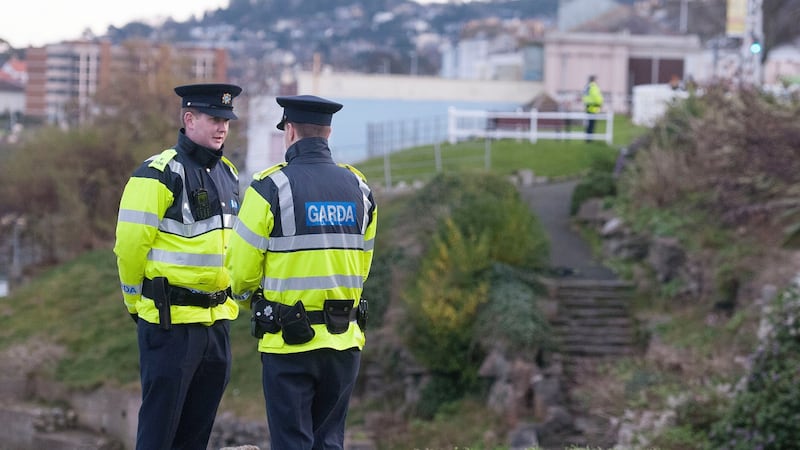The iPhone app was supposed to offer some level of reassurance – it would show the location of the 15-year-old boy as he moved around Dún Laoghaire and hopefully alert his mother and father if he was up to no good.
When his parents checked it anxiously over the afternoon of December 23rd, 2017, it seemed to be doing its job. The app showed the teenager walking from place to place in the town, places where young people typically hung out. First he was at the shopping centre, and then York Road, then the “baths”, a set of crumbling swimming areas set into the coastal wall.
But the app didn’t show that the boy was not with his friends but with a woman 10 years older than him. And it didn’t show him slitting that woman’s throat and leaving her to die.


According to the boy’s mother it was the first time in months he had been let out alone. Until very recently he had been plagued by hallucinations and desires to kill or harm others.
He was being monitored around the clock and by October his parents were taking turns to sleep with him in the living room, his mother says, as she sits on the same large L-shaped couch where she spent night after night with her son, trying to calm the voices in his head.
But as Christmas approached the boy seemed to get much better. “It was like he turned a corner. He just looked so well and he said I’m going to meet my friends today. I said go out for a couple of hours. We tracked him on his phone.”
School
Sitting in their small but well-appointed apartment, the mother pours coffee as she details how her son’s problems began in primary school. A talented artist from a young age, he started drawing disturbing and violent imagery. He made his first suicide attempt in 2013.
In secondary school his mental state began to deteriorate rapidly. After he started attending a prestigious fee-paying school, he “started to get very depressed”, his mother said. The next year he again attempted suicide. He spent his 15th birthday in an emergency department.
While there he was seen by psychiatrist who said the boy needed “immediate in-patient treatment,” his mother says.
His parents moved him to another school but matters failed to improve. In October 2017 his mother also took him to Linn Dara, a HSE in-patient facility in Cherry Orchard for mentally ill children but was told there were no beds available. Afterwards she sat in the car park with her son and wept. “We knew there was nowhere else for us to go.”
His parents went to Pieta House for help. “They were very nice but they’re not designed for serious mental illness.”
The next stop was the Lucena Clinic in Wicklow, an outpatient facility which forms part of the HSE’s Child and Adolescent Mental Health Services (Camhs), where a doctor prescribed the then 15-year-old the anti-depressant Prozac.
Prozac is an old-style anti-depressant but it is the most well-tested in children, the mother explains.
By this stage the boy’s parents were worried about him harming not just himself, but others, and decided to start monitoring him around the clock. This included sleeping in the same room as him and having a family friend watch him while they were at work.
“He had told every single one of them that he was worried he was going to kill somebody,” his mother says. “He was drawing terrifying pictures. It was terrifying stuff, like he was in the horrors.”
In November, the boy’s father returned home to find him trying to kill himself again. According to his mother, the boy said he was worried he was going to hurt someone and wanted to stop himself going through with it.
The boy’s doctor began doubling the Prozac dose every week. This continued until the boy got into a fight.
“He is very gentle, keeps himself to himself. He had never got into a fight before,” his mother said. The teen said afterwards he felt ‘really strong’.”
His doctor saw this as a red flag and briefly stopped increasing the Prozac dose. However the following week it was increased again. By December he was on one-and-a-half times the recommended adult dose, his mother says. Despite the high dose, the drug seemed to be having little impact. “He was getting constant, intrusive, violent thoughts.”
Video games
He wasn’t attending school much and spent most of the day at home playing video games. According to his mother: “He didn’t play violent games, more managerial ones. Prison Architect was one he liked and the ones where you build cities. Games where he’d build worlds.”
Then something unexpected happened. The boy’s condition seemed to rapidly improve. “It all happened over an eight-day period – looking back, I realise it was too much of a recovery, he was too well,” she says.
Unknown to his parents, also around this time the boy had downloaded a social media app called Whisper and had started to use it to talk to strangers online.
“Whisper is the best place to discover secrets around you,” the app’s website states. It is targeted primarily at teenagers as a way of sharing stories or “confessions” with strangers.
One of the people he started talking to was Stephanie Ng, a 25-year-old woman who was using the app to meet new people.
The boy claimed to be 19 and Stephanie asked him to send her a unique picture to prove this. She also asked that he do something unique in the photo, like touch his nose, so she would know it was him and not a picture of a random person downloaded from the web.
After a while the boy tried to steer the conversation towards sex. He asked her to participate in a threesome but she declined and made it clear that she wasn’t interested in any form of a sexual relationship.
He told her he had depression and suicidal thoughts and said he couldn’t commit to girls. “It’s like being a psychopath. You just don’t feel it,” he wrote, adding that he was “feeling it for the first time”.
The boy would later tell a psychologist that he wanted to meet someone so he could reject them “like I was rejected”.
Stephanie was selected at random he said. “I just wanted to attack somebody or a squirrel but no squirrel came.”
He felt powerful, “like there was new blood in my veins”, he told the psychologist. He said he believed attacking the woman would stop the intrusive thoughts.
The baths
Stephanie and the boy made plans to meet up on December 23rd and go for a walk around Dún Laoghaire. He promised to show her a “secret spot” and she joked that it sounded like he was going to murder her. “I don’t think I could murder you,” the boy replied.
Once the plans were in place the boy “shut down his emotions and the performer kicked in”, he later said. His mother described “the performer” as a villainous persona occupying her son’s head.
“He said at that point he just felt like a different person and the real world didn’t apply to him. They call it activation syndrome.”
Before meeting Stephanie the boy went to Lidl and purchased a kitchen knife, having realised during an earlier shopping trip with his father that “anyone could buy a knife.”
The two met up at the entrance to Dún Laoghaire Shopping Centre just after noon before they walked to a derelict house on York Road. The boy suggested they go inside but Stephanie declined. He suggested another house. Again she said no.
They strolled along the promenade and the boy suggested they go to the water’s edge to take a selfie. He walked her down the stone steps to the baths area, out of view of anyone walking along the path above.
Moments later, as Stephanie faced out to sea, the boy grabbed her from behind and held her in a headlock. He then moved in front of her and started choking her with his right hand while brandishing a knife in his left.
“I will do anything for you. I will be your friend,” she pleaded with him before losing consciousness. In a calm and controlled voice, the boy told her to be quiet.
Blood
Shortly after 3pm, Stephanie Ng woke to the sound of the sea crashing against the rocks and the squawking of seagulls above.
“This dream was comfortable until I realised it was reality and I was alive in a pool of my own blood,” she later told a court.
She looked down and saw the exposed flesh of her hand. She tried to cry for help but nothing came out.
“I knew I couldn’t be seen where I was lying and knew I had to get out of there to survive,” she explained. “I walked up to higher ground as I was determined not to die.”
Then she collapsed.
This effort likely saved her life. It made her visible to a pedestrian who was passing by on the Coast Road. She tried to speak to him but again nothing came out. It was then that Stephanie put her hand to her neck and realised exactly what the boy had done.
There was a 10cm knife wound across the front of her throat, a wound which had seemingly been inflicted after she lost consciousness.
The cut went 75 per cent through her windpipe and damaged her voicebox. The boy would later describe a “sawing” motion when asked how he inflicted it. One garda would later describe the wound as “if someone tried to cut off her head but got interrupted half way through”.
There were other wounds, including cuts to her face and a severed tendon in her hand, inflicted as she tried to defend herself from the boy. It also appeared the boy had tried to cut one of his initials into her finger.
The pedestrian tried to stop the bleeding. He was soon joined by other passersby and then gardaí and paramedics who frantically worked to save the woman’s life.
Meanwhile the boy walked home, stopping in a restaurant to wash the blood from his hands in its bathroom. He had already thrown the knife in the sea.
Once home, his parents didn’t suspect anything was wrong. As far as they were concerned, their son had turned a corner and they could look forward to a family Christmas together.
“I thought he’d be back at school after Christmas. I really thought the Prozac was working and I was desperate for it to work as well,” his mother recalls.
Stephanie was rushed to hospital. She had lost a lot of blood and her blood pressure was dangerously low. Almost immediately, doctors induced a coma before performing emergency surgery to close the wound.
She regained consciousness the next day – Christmas Eve –and with great difficulty was able to speak to gardaí and indicate to them to look at the Whisper app on her phone.
Whisper
What sets the Whisper app apart from Facebook or Twitter is its claims of complete anonymity – users can share any details without fear of their real identity becoming known.
In reality, it does retain some information on its users and shares this information with the authorities on request when a crime has been committed.
The gardaí had no need to go down this route. Stephanie showed detectives the chats between her and the boy and the photographs he had sent her. Before long they had a very good idea of who they were looking for; they even knew what he was getting for Christmas the next day – an electric keyboard.
By Christmas morning, detectives had an address for the boy but they faced a dilemma. The sadistic nature of the crime combined with the contents of the Whisper app indicated they were dealing with a potentially extremely dangerous suspect.
There was a concern the boy could harm his family if given the chance. It was decided they needed to place him under arrest as quickly as possible.
They knocked on the door and when it was answered they rushed in, each garda checking a different room. There was no sign of the boy. Then one of the gardaí realised in their haste they’d missed a door directly beside the front door. Inside they found the boy, with his headphones on, playing his new electric piano.
“This is about the stabbing of that girl in Dún Laoghaire, I haven’t got the knife. I threw it in the ocean,” he told gardaí.
“He said it immediately. [My son] doesn’t lie, he says everything,” his mother says.
The boy was placed under arrest and brought to Dún Laoghaire Garda station with his father. His mother remained home to mind his younger brother.
Gardaí also seized a Leinster rugby backpack and a coat, both with blood staining, and a journal containing various writings and sketches. One of the entries, made on December 17th, was a drawing of someone being cut up with a knife.
Another entry from November, referenced a therapist and stated: “Serial killer might also be self-deprecator might also be self-praiser.”
In the station, gardaí were disconcerted by the boy’s seemingly calm attitude. He asked questions about the place “as if he was on a school tour,” a garda later recalled. At one point during his five Garda interviews, he appeared to laugh inappropriately. Other than that, he mostly declined to comment.
While in Garda custody, the boy tried to kill himself twice, his mother says.
Oberstown
There are signs of the boy everywhere in Oberstown Child Detention Campus in north Dublin. His impressive artworks hang on the walls, including a remarkable 11 foot by 11 foot mural dedicated, according to his mother, to the theme of children’s rights.
In the education unit, a brightly painted collection of classrooms catering for the campus’s 47 young people, the boy’s name sits atop a list announcing the results of a recent table quiz.
In many ways the place is his home now and will be for the foreseeable future. The now 17-year-old is currently the longest serving detainee on campus and has spent longer on remand, nearly two years, than any other child in recent history.
The boy comes from a very different background to the other boys in Oberstown, who mostly come from economically deprived backgrounds. Between a third and a half of detainees have lost a parent, either through death, imprisonment or no long-term contact, and over 70 per cent have drug or alcohol issues.
But, according to his mother, the boy fits in well enough. “By now he’s the established one there.”
The delay in sentencing has been caused not by a trial – the boy pleaded guilty in late 2018 – but by the difficulty the court had finding qualified professionals to assess him. In the end, Dr Richard Church, a forensic child psychiatrist, had to be brought over from the UK.
The boy was first remanded to Oberstown on December 27th following his first appearance in the Children Court. An application for bail was denied after Det Garda Daniel Treacy told the court he believed the teenager would “likely commit murder if released”, a remarkable assertion to make about an accused, especially a 15-year-old.
Treacy’s opinion, which was accepted by the judge, was at least partly based on the planned and sadistic nature of the attack, as well as the contents on the boy’s journal.
Almost immediately after his committal the boy was visited by Prof Harry Kennedy, the director of the Central Mental Hospital, who put him on an anti-psychotic drug.
“It just had an amazing impact, it was like flicking a switch. [My son] was back,” his mother says. “He lost all the badness and all the dark thoughts.”
She continues to visit her son four times a week and speaks to him for half an hour each evening by phone. “I’m a bit of an oddity up there. They are well used to me coming in.”
She says she views any time she gets to spend with her son as a bonus. “My worry is that he’ll kill himself, so it’s all kind of like extra time. I’m kind of grateful for that.”
Although his hallucinations have abated he is still viewed as being at a high risk of “completing suicide”, as the doctors call it. He has self-harmed on at least 12 occasions while on remand.
Asked if she believes her son can ever live a normal life, the woman takes a moment before responding. “Yeah, I can see him going to art college one day, but I think he is seriously mentally ill and it will take some treatment.” She points towards a stack of paintings in the corner of the living room. “He did all of those”.
The boy has completed his Junior Certificate while in Oberstown and will sit his Leaving there too. His mother expected a sentence of at least eight years but he has been given 11 years.
That means in just over a year the boy will have to move from Oberstown to an adult prison, most likely Wheatfield, a prospect his mother is dreading.
“The psychiatrists have all said that he’s not suitable for an adult prison.”
Dr Church has suggested a secure mental health facility in England but such a move would probably be legally problematic.
A more likely possibility is the boy will be transferred to the Central Mental Hospital (CMH) in Dundrum (soon to be relocated to Portrane in north Co Dublin), the only secure unit in Ireland for mentally ill people who have committed an offence. This also concerns his mother as there are no school facilities there.
If the boy was so obviously mentally ill at the time of the attempted murder, why didn’t he enter a plea of not guilty by reason of insanity?
His mother is emphatic. “Because with not guilty by reason of insanity you go straight to Dundrum and you don’t have a release date.”
People sent to the CMH on an insanity plea are only released when approved by a committee. Some patients have been there for many years, sometimes for much longer than the average life sentence, which stands at about 17 years.
Contrasts
Understandably, the picture painted of the boy by his mother is in some ways very different to the one portrayed in the Central Criminal Court during the various hearings that have taken place over the last year.
There are no signs of a personality disorder, such as psychopathy, in her son, she says. “They did all those tests and came in with nothing.”
In fact her son doesn’t yet have a definite diagnosis. “Harry [Kennedy] is very cagey about making a diagnosis.”
She said he had been viewing pornography “but it wasn’t a big thing” and it wasn’t of the extreme variety. Since being on the anti-psychotics he has felt remorse and guilt, she says. “He was crying every morning.”
She says he also cried in court as Stephanie gave her emotive victim impact report but “in a very quiet way”.
The boy’s mother puts much of the blame on the Prozac prescribed to her son. The drug is safe for adults, she says. “It’s just in teenagers I think the problem is. Because the mind is growing.”
It’s a debate which has been had before. The boy’s mother says she has been in touch with Leonie Fennell, the mother of Shane Clancy, a 22-year-old who in 2009 stabbed his ex-girlfriend’s new partner, Sebastian Creane, to death before taking his own life.
Clancy was taking Citalopram, another anti-depressant from the selective serotonin reuptake inhibitor (SSRI) family of drugs. He had been prescribed it for the first time shortly before the murder.
Fennell blamed the drug for what she said was an extreme personality change which overcame her son before the murder. At his inquest in 2010, Prof David Healy from the University of Cardiff testified that in a small number of cases anti-depressants can cause people to become potentially homicidal or suicidal.
The case caused a minor controversy in the psychiatric community. Prof Patricia Casey, on behalf of the College of Psychiatrists of Ireland, rejected Healy's opinion but was not permitted to give evidence by the coroner.
Psychiatrist Prof Ted Dinan told this newspaper at the time that he could say with “100 per cent certainty and without any fear of contradiction” that modern anti-depressants do not cause people to commit murder. Fennell continues to campaign and highlight what she says are the potential dangers of SSRIs.
Contradicting evidence
The mother of the boy who attempted to murder Stephanie Ng spoke to The Irish Times last July, the day before her son’s sentencing hearing. As she speaks, her laptop makes a sound; it’s an email containing Dr Church’s assessment.
When the doctor takes the stand the next day, his evidence appears to contradict some of what the boy’s mother says.
There were several indications of an emerging personality disorder, according to Church and the boy shows low levels of empathy and remorse. This, combined with other factors such as the anger he feels at the world, means the boy continues to pose a danger to the life of himself and of others.
This is a danger which will increase during high-stress occasions, he said.
The boy also told the doctor he was watching extreme pornography before the attack without the knowledge of his parents and that he had been watching adult content since the age of 11 or 12.
Asked if he watched violent pornography, the boy told Church: “Maybe force but not violent, never blood or choking.”
He also said he used anonymous browsing software to access content on the dark web which was “very illegal and messed up”.
The boy told the psychiatrist that he now regretted his actions because he had hurt everyone. He reported feeling complete remorse and said what he did was “cruel, demonic and evil”.
After the attempted murder he was shaking but “didn’t really feel anything”. He said he was surprised to learn later the victim had survived. “First, I was not happy she survived because it meant there was more evidence against me,” he said. Later he was glad he hadn’t killed her because “it meant I wasn’t a murderer.”
Church said he couldn’t comment either way on what role Prozac played. He agreed it can have a “disinhibiting” effect in some cases but said he would need access to the boy’s full medical records to give a proper opinion.
What would the boy’s mother say to people who believe she is just making excuses for her son’s awful crime?
“I could see why you’d want to say that. But 15-year-olds don’t just go out and attack like that out of the blue.”
Stephanie Ng
Stephanie Ng did not respond to a request for interview made through a family member. However, the consequences of the attack were laid out in a powerful, emotive and at times harrowing victim impact statement.
The boy “destroyed” her life, she told the court.
Turning in the witness box to address him directly, she said: “When they told me your age my head spiralled in confusion trying to understand how someone your age can have such evil intentions.
“The scars you inflicted on my neck and hand will forever be a reminder of your demonic actions. You tried a number of times that day to lure me to isolated locations in order to fulfil your urges.”
She continued: “Your persistence down at the water’s edge showed how determined you were to have me dead.”
Stephanie told the court she was looking forward to the day she would be free of the memories of the attack. “All I can do is trust and believe, because the thought of this lasting for the rest of my life is intolerable”.
What would the boy’s mother say to Stephanie Ng if she had an opportunity? “She has just been very gracious and courageous, she really is amazing. I suppose we would say that we’re just so sorry.”



















